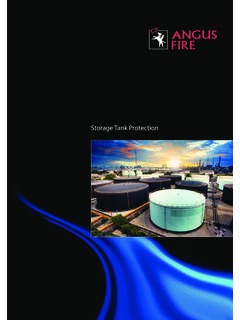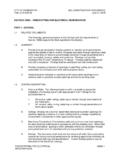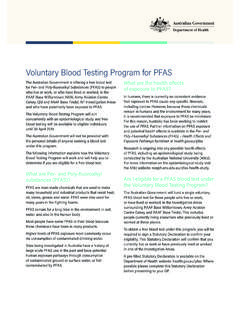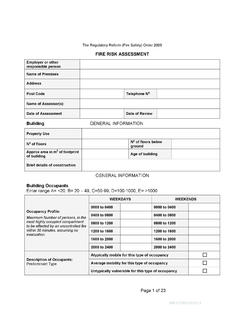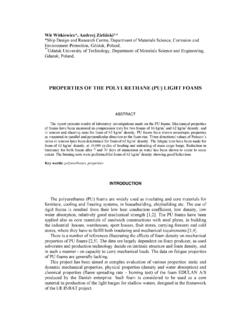Transcription of Phase I Final Rule and Technical Development Document of ...
1 This Document is part of Appendix A, AFFF NOD (Aqueous Film-Forming Foam): Nature of Discharge for the Phase I Final Rule and Technical Development Document of Uniform National Discharge Standards (UNDS), published in April 1999. Phase I Final Rule and Technical Development Document of Uniform National Discharge Standards (UNDS) Appendix A AFFF NOD (Aqueous Film-Forming Foam; Nature of discharge) April 1999 NATURE OF DISCHARGE REPORT Aqueous Film Forming Foam (AFFF) INTRODUCTION The National Defense Authorization Act of 1996 amended Section 312 of the Federal Water Pollution Control Act (also known as the Clean Water Act (CWA)) to require that the Secretary of Defense and the Administrator of the Environmental Protection Agency (EPA) develop uniform national discharge standards (UNDS) for vessels of the Armed Forces for.
2 Discharges, other than sewage, incidental to normal operation of a vessel of the Armed Forces, .. [Section 312(n)(1)]. UNDS is being developed in three phases. The first Phase (which this report supports), will determine which discharges will be required to be controlled by marine pollution control devices (MPCDs) either equipment or management practices. The second Phase will develop MPCD performance standards. The Final Phase will determine the design, construction, installation, and use of MPCDs. A nature of discharge (NOD) report has been prepared for each of the discharges that has been identified as a candidate for regulation under UNDS. The NOD reports were developed based on information obtained from the Technical community within the Navy and other branches of the Armed Forces with vessels potentially subject to UNDS, from information available in existing Technical reports and documentation, and, when required, from data obtained from discharge samples that were collected under the UNDS program.
3 The purpose of the NOD report is to describe the discharge in detail, including the system that produces the discharge, the equipment involved, the constituents released to the environment, and the current practice, if any, to prevent or minimize environmental effects. Where existing process information is insufficient to characterize the discharge, the NOD report provides the results of additional sampling or other data gathered on the discharge. Based on the above information, the NOD report describes how the estimated constituent concentrations and mass loading to the environment were determined. Finally, the NOD report assesses the potential for environmental effect. The NOD report contains sections on: Discharge Description, Discharge Characteristics, Nature of Discharge Analysis, Conclusions, and Data Sources and References.
4 Aqueous Film Forming Foam (AFFF) 1 DISCHARGE DESCRIPTION This section describes the AFFF and includes information on: the equipment that is used and its operation (Section ), general description of the constituents of the discharge (Section ), and the vessels that produce this discharge (Section ). Equipment Description and Operation AFFF is the primary firefighting agent used aboard Coast Guard (USCG) and Navy vessels for flammable liquid fires. A different class of agents, Fluoroprotein foams, are used for the same purpose on vessels in the Military Sealift Command (MSC). Aqueous Film Forming Foam (AFFF) is a particular type of synthetic firefighting foam whose performance is governed by military specification. Fluoroprotein foam is a protein-based material to which fluorinated surfactants have been added to improve fluidity and surface tension properties, while reducing the tendency of the protein base to absorb liquids.
5 These foams control and extinguish flammable liquid fires and help prevent such fires after spills by spreading a vapor-sealing film over the flammable liquid. The foam layer effectively excludes oxygen from the surface of the fuel, while the high water content cools the surface. The foam layer also provides a reservoir that will reseal a disturbed fuel surface and inhibit reignition. Both foams have excellent wetting or penetrating characteristics can be used against fires involving densely packed wood, wood products, cloth, textile and fibrous materials, paper, and paper products. Both types of foam concentrates can be stored for indefinite periods in approved equipment and systems with no degradation in chemical properties or capabilities. In use, foam concentrate is mixed with seawater to form a dilute seawater foam solution.
6 Seawater foam solution is generated in foam proportioning stations or by portable Each type involves metering foam concentrate into pressurized, firefighting seawater. The metering accuracy of the proportioning stations is verified by periodic tests. Foam is applied both manually, with conventional foam or water/fog equipment such as fire hoses equipped with foam nozzles, and from fixed sprinkler devices. Fixed systems provide seawater foam solution to sprinklers on flight decks, and to overhead sprinklers in hangars, tank decks, well decks, weapon elevator pits, fueled vehicle decks or holds, refueling stations, and fuel pump rooms. If a protected area requires a greater flow rate than can be supplied by a single proportioning station, the area is subdivided into zones or groups, each independently supplied from a single proportioning station.
7 Bilge sprinkler systems are installed in machinery spaces and pump rooms. Firefighting hose reel stations are supplied through a system of proportioners, pumps, and permanently installed piping. Foam concentrate is stored in tanks, 55-gallon drums, and 5-gallon cans. Aircraft carriers, large amphibious ships, and other large ships can carry more than 20,000 gallons of AFFF or fluoroprotein foam concentrate. Neither AFFF nor fluoroprotein foam is ever discharged from vessels in concentrated Aqueous Film Forming Foam (AFFF) 2 form. Only the dilute seawater foam solution is discharged. Incidental discharge of seawater foam solution occurs during maintenance that is part of the Planned Maintenance System (PMS), Board of Inspection and Survey (INSURV) underway material inspections (UMI), flight deck certifications, or biennial tests on MSC vessels by the USCG Office of Marine Inspection.
8 Regular preventive maintenance of firefighting systems and equipment requiring the discharge of seawater foam solution aboard ship occurs annually during PMS activities, although some maintenance is performed at 18 month intervals. Table 1 indicates the frequency of foam solution discharges on Navy, MSC, and USCG vessels. For Navy vessels, an INSURV UMI occurs every 3 years and involves the same system checks and resulting seawater foam discharges as the annual PMS activities. An MSC damage control instruction requires that foam solution be present at flight deck nozzles before every flight operation (approximately twice per month per vessel), which is verified by operating the nozzles until foam is For aircraft carriers, Navy requirements call for a flight deck certification during the first deployment to sea after a shipyard or repair period (approximately every years).
9 Other than aircraft carriers, ships with flight decks, whether Navy or MSC, receive flight deck certification inspections every 3 years that test for foam solution at all flight deck nozzles and hoses. Releases to the Environment The seawater foam solutions that are discharged onto flight and weather decks as a result of maintenance, inspection, and certification activities are washed overboard with pressurized seawater from fire hoses, or by activating the seawater washdown system. Foam that is discharged into internal ship compartment bilges during system testing and flushing evolutions is pumped overboard by eductors. Seawater foam discharge will contain all the constituents from the firemain, in addition to constituents unique to the foam concentrate. As discussed more fully in the Firemain Systems NOD Report, the principal constituent of the firemain discharge that could have an adverse water quality effect is copper, derived from the copper nickel firemain piping.
10 Therefore, copper will be an expected component of the AFFF solution discharge. Vessels Producing the Discharge All Navy surface ships, all classes of USCG cutters, icebreakers and icebreaking tugs, and MSC ship classes with the ability to support helicopter operations produce the discharge. Table 2 shows the vessel classes that produce the discharge. DISCHARGE CHARACTERISTICS This section contains qualitative and quantitative information that characterizes the discharge. Section describes where the discharge occurs with respect to harbors and near shore areas, Section describes the rate of the discharge, Section lists the constituents in the discharge, and Section gives the concentrations of the constituents in the discharge. Aqueous Film Forming Foam (AFFF) 3 Locality The Navy provides instruction on where seawater AFFF solutions can be discharged during maintenance that tests the proportioning accuracy of AFFF proportioning stations.











